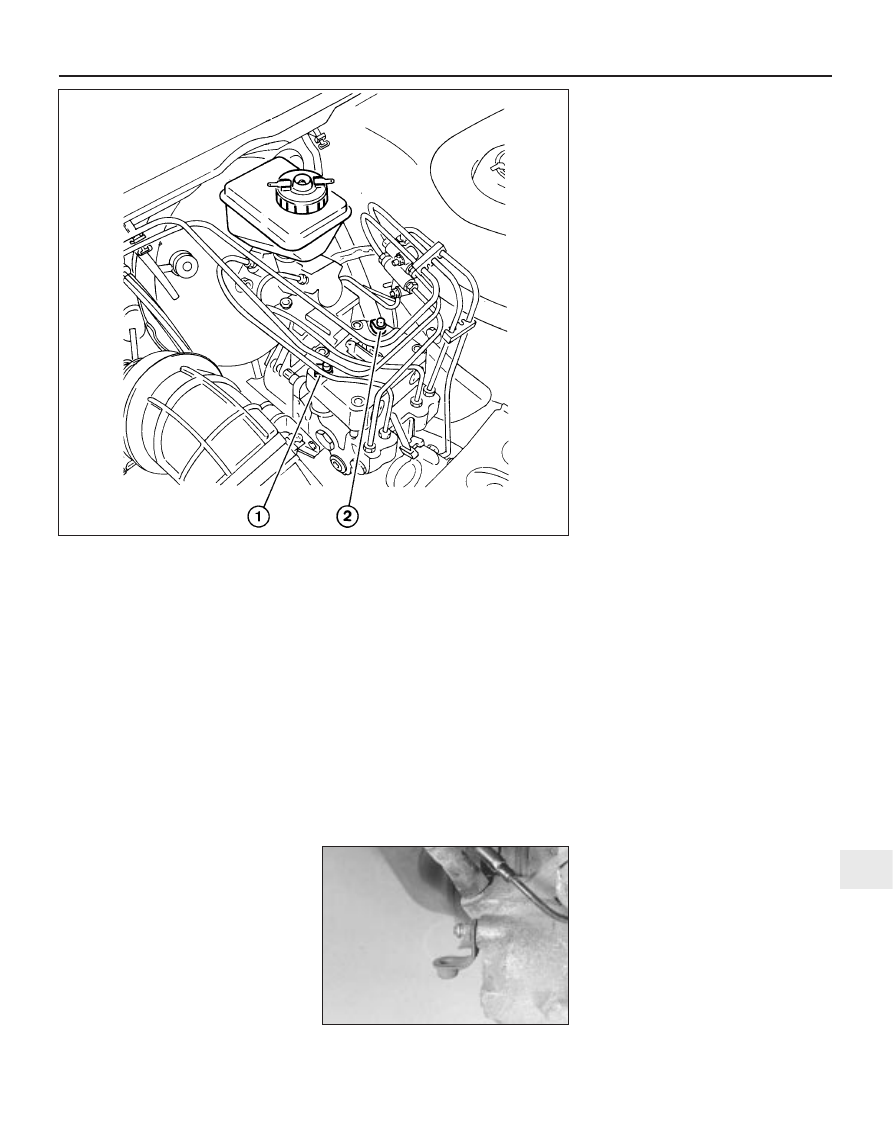содержание .. 32 33 34 35 ..
Peugeot 205. Manual - part 34

Bleeding - basic (two-man)
method
13 Collect a clean glass jar of reasonable size
and a suitable length of plastic or rubber
tubing, which is a tight fit over the bleed
screw, and a ring spanner to fit the screws.
The help of an assistant will also be required.
14 If not already done, remove the dust cap
from the bleed screw of the first wheel to be
bled and fit the spanner and bleed tube to the
screw (see illustration). Place the other end
of the tube in the jar, and pour in sufficient
fluid to cover the end of the tube.
15 Ensure that the master cylinder reservoir
fluid level is maintained at least above the
“MIN” level line throughout the procedure.
16 Have the assistant fully depress the brake
pedal several times to build up pressure, then
maintain it on the final downstroke.
17 While pedal pressure is maintained,
unscrew the bleed screw (approximately one
turn) and allow the compressed fluid and air to
flow into the jar. The assistant should maintain
pedal pressure, following it down to the floor if
necessary, and should not release it until
instructed to do so. When the flow stops,
tighten the bleed screw again have the
assistant release the pedal slowly, and
recheck the reservoir fluid level.
18 Repeat the steps given in paragraphs 16
and 17 until the fluid emerging from the bleed
screw is free from air bubbles. If the master
cylinder has been drained and refilled, and air
is being bled from the first screw in the
sequence, allow approximately five seconds
between cycles for the master cylinder
passages to refill.
19 On 1.6 GTI models only it is now
important to dislodge air trapped in the inertia
compensator. To do this, open the bleed
screw again and have your assistant fully
depress and release the brake pedal rapidly 4
or 5 times, finally keeping the pedal
depressed before tightening the bleed screw.
20 When no more air bubbles appear, tighten
the bleed screw securely, remove the tube
and spanner and refit the dust cap. Do not
overtighten the bleed screw.
21 Repeat these procedures on the
remaining brakes in sequence until all air is
removed from the system and the brake pedal
feels firm again.
Bleeding - using a one-way
valve kit
22 As their name implies, these kits consist of
a length of tubing with a one-way valve fitted,
to prevent expelled air and fluid being drawn
back into the system; some kits include a
translucent container, which can be positioned
so that the air bubbles can be more easily
seen flowing from the end of the tube.
23 The kit is connected to the bleed screw,
which is then opened. The user returns to the
driver’s seat, depresses the brake pedal with
a smooth steady stroke, and slowly releases
it; this is repeated until the expelled fluid is
clear of air bubbles. When using one of these
kits on 1.6 GTI models, remember to carry out
the procedure described in paragraph 19 after
bleeding the first brake in the sequence.
24 Note that these kits simplify work so
much that it is easy to forget the master
cylinder fluid level; ensure that this is
maintained at least above the “MIN” level line
at all times.
Bleeding - using a pressure-
bleeding kit
25 These kits are usually operated by the
reserve of pressurised air contained in the
spare tyre. However, note that it will probably
be necessary to reduce the pressure to a
lower level than normal; refer to the
instructions supplied with the kit.
26 By connecting a pressurised, fluid-filled
container to the master cylinder reservoir,
bleeding is then carried out by simply opening
each bleed screw in turn (in the specified
sequence) and allowing the fluid to run out,
until no more air bubbles can be seen in the
expelled fluid. When using one of these kits
on 1.6 GTI models, remember to carry out the
procedure described in paragraph 19 after
bleeding the first brake in the sequence.
27 This method has the advantage that the
large reservoir of fluid provides an additional
safeguard against air being drawn into the
system during bleeding.
28 Pressure bleeding is particularly effective
when bleeding “difficult” systems, or when
bleeding the complete system at the time of
routine fluid renewal.
All methods
29 When bleeding is complete, and firm
pedal feel is restored, wash off any spilt fluid,
tighten the bleed screws securely, and refit
their dust caps.
30 Check the hydraulic fluid level in the master
cylinder reservoir and top-up if necessary.
31 Discard any hydraulic fluid that has been
bled from the system; it will not be fit for re-use.
32 Check the feel of the brake pedal. If it feels
at all spongy, air must still be present in the
system, and further bleeding is required.
Failure to bleed satisfactorily after a reasonable
repetition of the bleeding operations may be
due to worn master cylinder seals.
33 On models with ABS, reconnect the wiring
connectors to the regulator unit and
reconnect the battery.
Braking system 9•3
9
2.12 Bleed screws (1 and 2) on ABS regulator unit
2.14 Bleed screw and dust cap on front
brake caliper